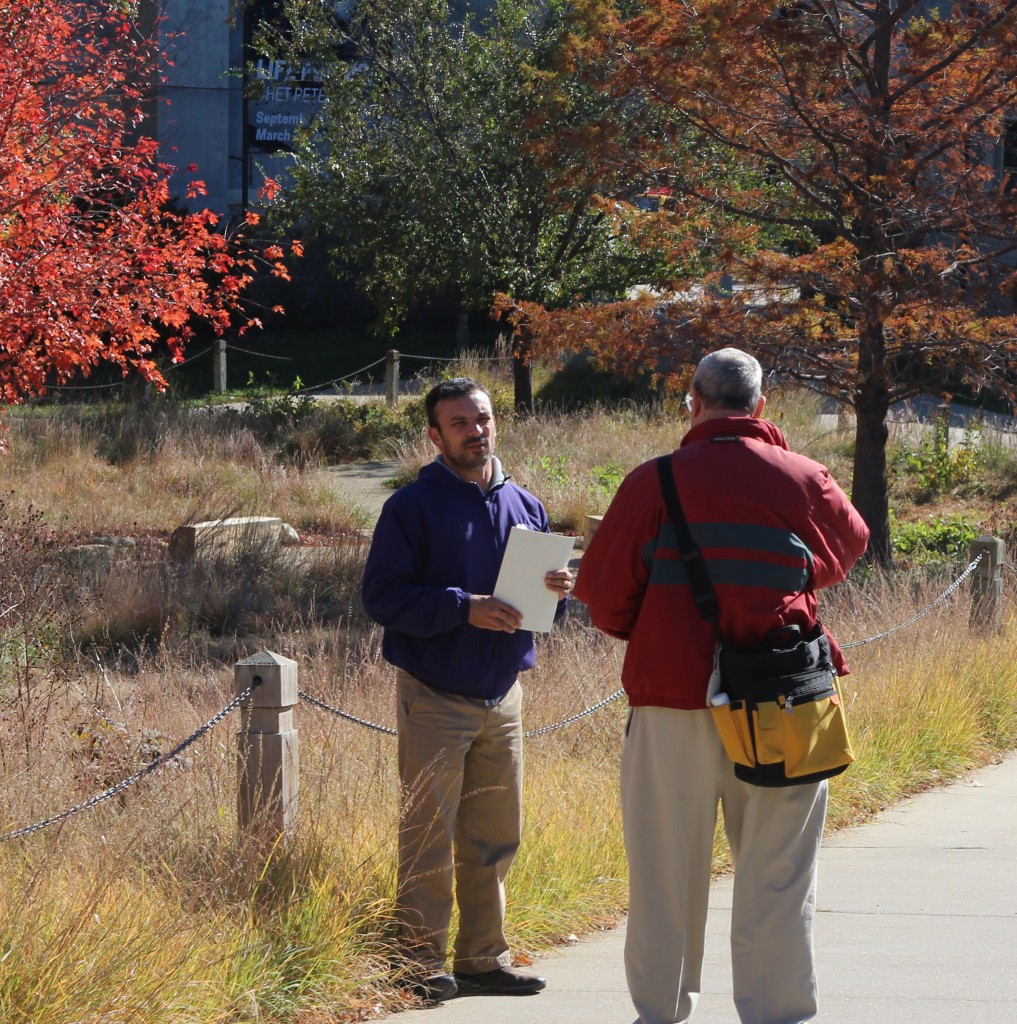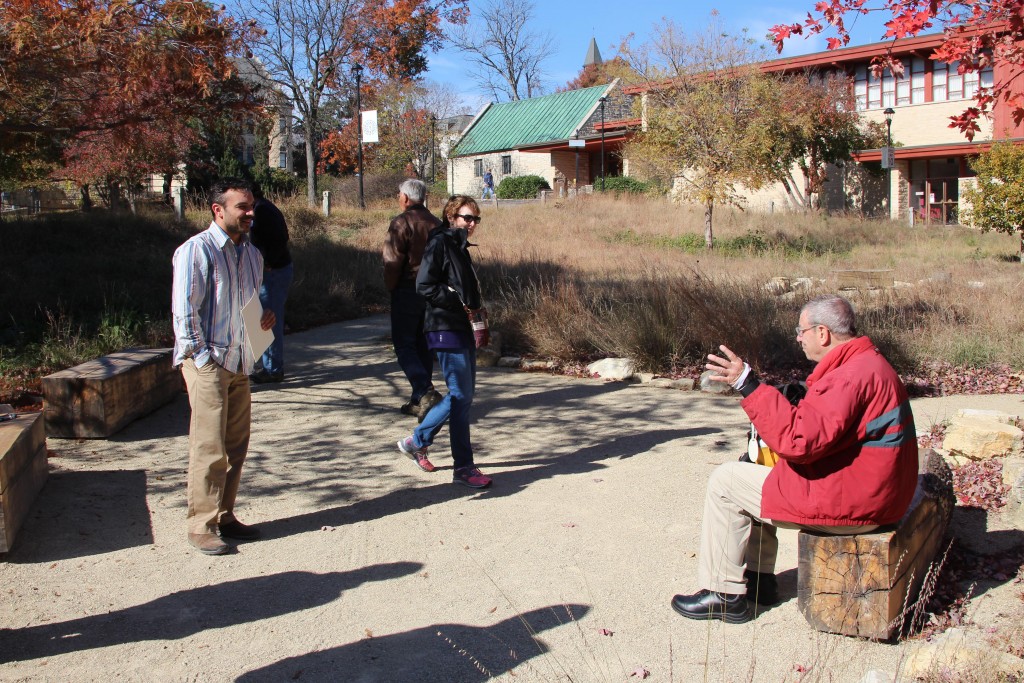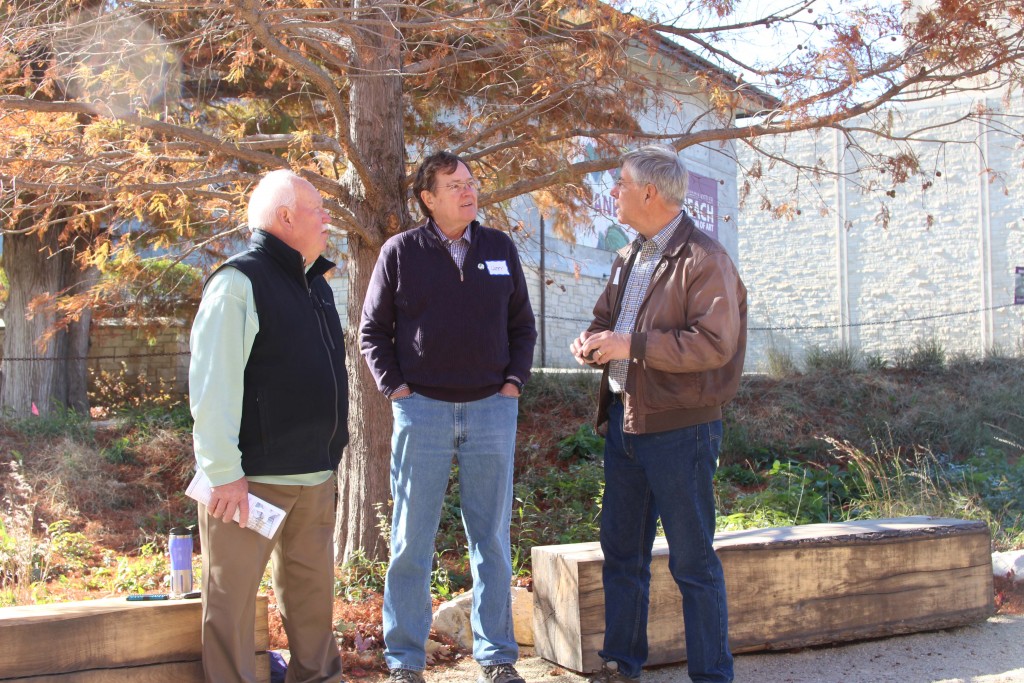
Post written by Richard Dean Prudenti and Katie Kingery-Page.
Seeding of the Meadow began nearly two years ago. In that time the campus and community have witnessed the growth of a native plants landscape at K-State, just north of the Beach Museum of Art. Many people have shown great appreciation for the plants, the habitat and the landscape design elements. This became apparent when Richard Prudenti (graduate student in landscape architecture and co-author of this post) provided a tour of the Meadow for several alumni of landscape architecture during the 50th Anniversary celebration of the landscape architecture program at K-State.

The alumni questions and observations were enlightening, as this was their first visit to the Meadow. For example, one person inquired about the non-native trees in the landscape: How is it possible to create a sustainable Meadow with the current tree inventory? Will we replace them with native trees? As we await the regrowth of spring, we want to take a moment to answer these questions and others posed by visitors to the Meadow:
Q: Will we replace the current tree inventory with native trees?
A: The site currently holds six trees; two are native to Kansas: a Chinquapin Oak and an Eastern Red Cedar. The trees provide shade conditions that are much denser than that of an upland prairie, but this canopy does evoke a savannah-like feeling. Understanding the amenity of healthy trees in a campus environment, it makes sense to preserve these trees for their qualities of shade and enclosure of space. To a purist, preserving the healthy non-native trees that came with the site might be anathema, but the Meadow is a landscape of compromise between human needs and the desire to showcase native plants.
Our plan is that in a few more years, the Meadow can sustain itself and require very little maintenance. But just as in a natural grassland, tree seedling growth must be suppressed. Currently, seasonal mowing suppresses seedling trees in the Meadow.
Q: How was the under-story of plants designed?
A: The plant palette is drawn from the documented plant composition of the nearby Konza prairie, and includes species selected for a cohesive aesthetic effect as well as creation of animal habitat and a resource for understanding human use (for example, some native species are used by pollinators; others have been used by people for food and dye plants). Species were combined in five different mixes in response to sun/shade and edge conditions of the site. Still in its second year and a work in progress, it will take 3-5 years to reach the point where the Meadow maintains a dynamic equilibrium of native grasses and wildflowers.

During the 2014 growing season, transplantation of plants from K-State greenhouses increased species on site from 20 to more than 40, including milkweed and other species that provide food and habitat for Monarch butterflies and other pollinators. In the future, monitoring pollinators will be paramount to validating the Meadow’s existence and perhaps supporting the creation of additional “meadows” on campus.
Q: Will the Meadow be burned at some point?
A: Gaining permission for controlled burns is a concern, especially as close as the Meadow is to the Beach Museum of Art, McCain Auditorium, All Faiths Chapel, and other campus buildings. We feel a controlled burn could be safely planned as a celebratory and educational event. If the planning team is successful in obtaining permissions, a burn still cannot be held until the plants have sufficient root growth to survive a fire–typically not until 2-3 years after planting.
Q: What are the sustainability goals of The Meadow?
A: We have altered the landscape from turfgrass to native plants with far less water and chemical use than conventional lawns. Once fully‐established, the Meadow’s need for herbicides/pesticides and water usage beyond rainfall should be minimal or nonexistent. In addition, we believe the Meadow will decrease stormwater runoff into existing inlets on the site. We hope to begin monitoring stormwater runoff, chemical and water inputs, in comparison to a typical campus site, later this year.
Q: Will there be lighting in the Meadow?
A: Currently there is not a budget for expanding electrical service on the site and adding light fixtures. Our aspiration is to develop artful lighting.
Q: How is this landscape funded?
A: Thus far, the Meadow has been made possible by the generosity of private citizens such as the Hummel family (William and Sara Hummel Memorial Fund) and the Henley family (John and John T. Henley Meadow Excellence Fund). K-State’s Green Action Fund, a pilot fund through the Student Government Association, has also provided support. In addition, numerous in-kind hours of work have been given by faculty, staff, and community. We continue to seek out funds to accomplish a number of objectives.
Q: How will the memorial function of the Meadow be visually expressed?
A: From the beginning, the Meadow has served as a living memorial, which will be recognized on a sign planned for summer 2015. Since the construction, several people have approached the planning team asking that further memorials be incorporated in the Meadow. The Meadow planning team feels that for the meadow to function as a contemplative landscape, it must remain free of visual clutter. Thus, people have developed creative and meaningful ways to memorialize, including sponsoring and participating in planting days and donating seating elements.

Q: Will there be signage to explain the goals of the Meadow?
A: Every effort is being made to preserve the visual aesthetic of the Meadow. A subtle sign planned for the Meadow will refer visitors to a touchtable exhibit inside the museum. This display of visuals and information is currently under construction.
Q: Will we be monitoring the changes in soil and habitat, the use of water, etc.?
A: Kingery‐Page led an interdisciplinary team to plan and design the Meadow with “ecosystem services” in mind, as defined by the Sustainable Sites Initiative:
- Local climate regulation
- Air and water cleansing
- Erosion and sediment control (the former turfgrass had areas of erosion from runoff and native plants now slow and capture sediment).
- Hazard (flood) mitigation
- Pollination
- Habitat functions
- Human health and well‐being benefits
- Food and renewable non‐food products
- Cultural benefits
In Fall 2014, faculty from the departments of Landscape Architecture/Regional & Community Planning and Bio-Agricultural Engineering applied for an EPA grant to monitor several sites on campus. The research anticipated at the Meadow will compare the chemical and water inputs as well as stormwater infiltration at the Meadow to a typical turfgrass area of equal size on campus.
Q: What is the primary goal of this project?
A: One of the overarching goals is to heighten awareness of the need to protect grasslands worldwide. More than 49% of grasslands have been destroyed worldwide and only 4 percent are currently protected.
The Meadow is a setting for careful observation, discussion, and drawing activities, encouraging visitors to make meaningful connections between art, science, and enjoyment of the natural world. The site fosters lifelong learning about the Flint Hills ecoregion and sustainable landscape management.

A Special Thank You
We greatly appreciate those who participated in touring the Meadow fall 2014. Your interest in learning about the Meadow, its purpose, and what we might be doing next proved quite valuable in our planning efforts. Your thoughts and responses to the Meadow experience will continue to help us as we develop the Meadow.





